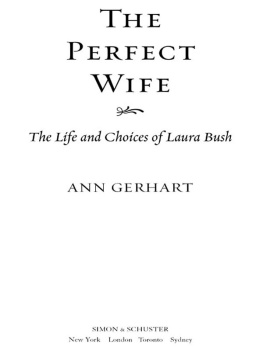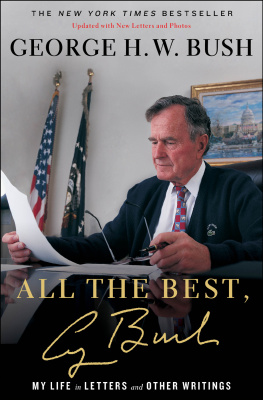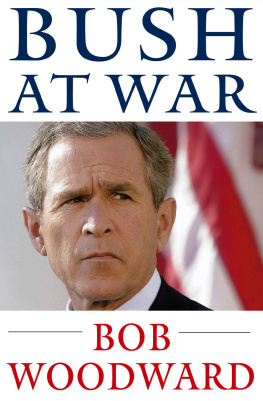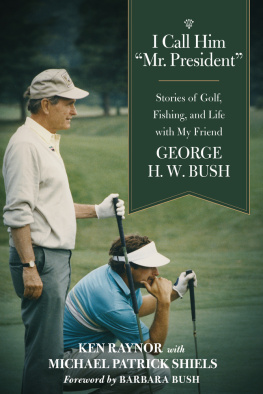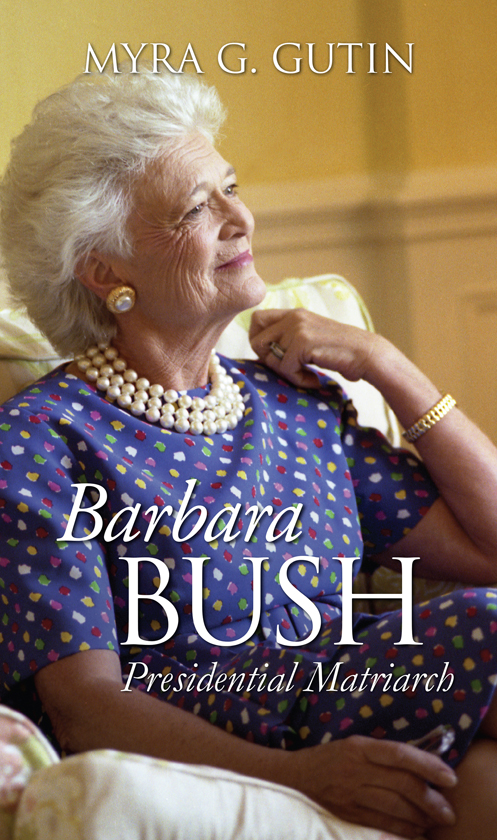BARBARA
BUSH
MODERN FIRST LADIES
Lewis L. Gould, Editor
TITLES IN THE SERIES
Helen Taft: Our Musical First Lady, Lewis L. Gould
Ellen and Edith: Woodrow Wilsons First Ladies, Kristie Miller
First Lady Florence Harding: Behind the Tragedy and Controversy,Katherine A. S. Sibley
Grace Coolidge: The Peoples Lady in Silent Cals White House, Robert H. Ferrell
Lou Henry Hoover: Activist First Lady, Nancy Beck Young
Eleanor Roosevelt: Transformative First Lady, Maurine Beasley
Bess Wallace Truman: Traditional First Lady, Sara L. Sale
Mamie Doud Eisenhower: The Generals First Lady, Marilyn Irvin Holt
Jacqueline Kennedy: First Lady of the New Frontier, Barbara A. Perry
Lady Bird Johnson: Our Environmental First Lady, Lewis L. Gould
Betty Ford: Candor and Courage in the White House, John Robert Greene
Rosalynn Carter: Equal Partner in the White House, Scott Kaufman
Nancy Reagan: On the White House Stage, James G. Benze, Jr.
Barbara Bush: Presidential Matriarch, Myra G. Gutin
Hillary Rodham Clinton: Polarizing First Lady, Gil Troy
BARBARA
BUSH
PRESIDENTIAL MATRIARCH
MYRA G. GUTIN

UNIVERSITY PRESS OF KANSAS
2008 by the University Press of Kansas
All rights reserved
All photographs are courtesy of George Bush Presidential Library, College Station, Texas.
Published by the University Press of Kansas (Lawrence, Kansas 66045), which was organized by the Kansas Board of Regents and is operated and funded by Emporia State University, Fort Hays State University, Kansas State University, Pittsburg State University, the University of Kansas, and Wichita State University
Library of Congress Cataloging-in-Publication Data
Gutin, Myra G.
Barbara Bush : presidential matriarch / Myra G. Gutin.
p. cm. (Modern rst ladies)
Includes bibliographical references and index.
ISBN 978-0-7006-1583-4 (cloth : alk. paper)
ISBN 978-0-7006-2740-0 (ebook)
1. Bush, Barbara, 1925
2. Presidents spousesUnited StatesBiography.
3. Literacy programsUnited StatesHistory.
4. ReadingUnited StatesHistory.
I. Title.
E883.B87G87 2008
2008 973.928092dc222008003945
British Library Cataloguing-in-Publication Data is available.
Printed in the United States of America
10 9 8 7 6 5 4 3 2 1
The paper used in the print publication is recycled and contains 50 percent postconsumer waste. It is acid free and meets the minimum requirements of the American National Standard for Permanence of Paper for Printed Library Materials Z39.481992.
This book is dedicated to
David Gutin
and
Laura, Sarah, and Andrew Gutin
who were there
and to
Lillian and Stanley Greenberg
who should have been
CONTENTS
EDITORS FOREWORD
Barbara Pierce Bush occupies a special position among first ladies. Not since Abigail Adams has a first lady been both the wife of one president and the mother of another chief executive. Beyond these family circumstances, Barbara Bush deserves attention for her performance in the White House from 1989 to 1993. Following the controversial Nancy Reagan and preceding the equally contentious Hillary Rodham Clinton, Bush established an enviable record for personal popularity as a first lady. The public took to her accessible style and self-deprecating approach. Even when her husbands presidency encountered difficult periods, Barbara Bushs poll ratings remained high. Only toward the end of George H. W. Bushs administration did his wife meet criticism for her views on abortion.
Myra Gutins book shows how carefully managed and executed Barbara Bushs success as first lady was. Gutin uses the records of Bushs many speeches, the only primary materials on her tenure in the White House now available, to show how the public image emerged. Barbara Bush was no White House innovator. Her speeches broke little new ground. Even in her main campaign for literacy, Bush emphasized exhortation and education over programmatic goals. Yet within these self-imposed limits, Barbara Bush was more of an activist than the public realized.
The narrative that Myra Gutin has fashioned also illuminates the intricate dynamics within Barbara Bushs family. Her interaction with her politically ambitious husband and her maternal effect on her oldest son are developed with great skill. Gutins work contributes to the historical literature on a complex and important presidential family even as it illuminates the record of a first lady whose popularity still endures.
Lewis L. Gould
PREFACE
Barbara Bush had been first lady for seven months when she spoke at a convocation at Smith College in September 1989. She took the opportunity to discuss the potential impact of her White House project, literacy. She quoted former first lady Lady Bird Johnson, who had said, It would be sad to pass up such a bully pulpit. Its a fleeting chance to do something for your country that makes your heart sing, and if your project is useful, and people notice it, and that reflects well on your husband, Heavens, thats one of your biggest roles in life. Mrs. Bush continued, Well thats exactly what literacy has been for me. I never could have guessed that I would end up with such a chance to be useful, and such an enormous return on a relatively modest effort.
Barbara Bush remains one of the most admired women in the world and a perennial selection to the Gallup Most Admired Woman poll. In 2006, she still ranked in the top ten among the polls vote getters. Americans hold Barbara Bush in high regard as the matriarch of an accomplished, powerful, and diverse family. She is seen as Americas grandmother, walking a dog and shepherding numerous grandchildren around the family compound in Kennebunkport, Maine. As first lady of the United States, she endorsed a successful literacy program that flourishes even though she has been gone from the White House for many years. With Abigail Adams, she shares the distinction of being only one of two women in American history to have been the wife of one American president and the mother of another. This is the public Barbara Bush, the wearer of faux pearls, the woman known for her distinctive white hair, the woman whose image the television program Saturday Night Live caricatured.
As with most public figures, there is much more to this complex person. Barbara Bush is also the tough, down-to-earth, sharp-tongued doyenne of a prominent political family that has had its share of sorrows and setbacks. She has surmounted the death of a child, depression, and a sometimes insensitive spouse. Self-deprecating humor and sarcasm have become both her trademark and her method of survival. She does not suffer fools and brooks no dissent; she can be combative and will go into full battle mode if her husband or children become the object of criticism. Savvy and smart, Barbara Bush presented a glossy family portrait of a large, loving, and supportive group, the ostensibly ideal American family. Behind the facade is a less sunny reality.
From 1989 to 1993, Barbara Bush presided over the White House as first lady. She shared certain characteristics with many first ladies: loyalty to spouse, a commonsense approach to life in the crosshairs of the media, a tendency to roll with the punches. Other qualities were unique to Barbara Bush: great bonhomie, significant patience, the ability to forgive but not forget. She has carefully crafted and nurtured her public image during her years on the international stage. Many people will say that they liked Barbara Bush, she seemed like a real person; at the same time, one felt that he or she should sit up straighter when in her presence.


